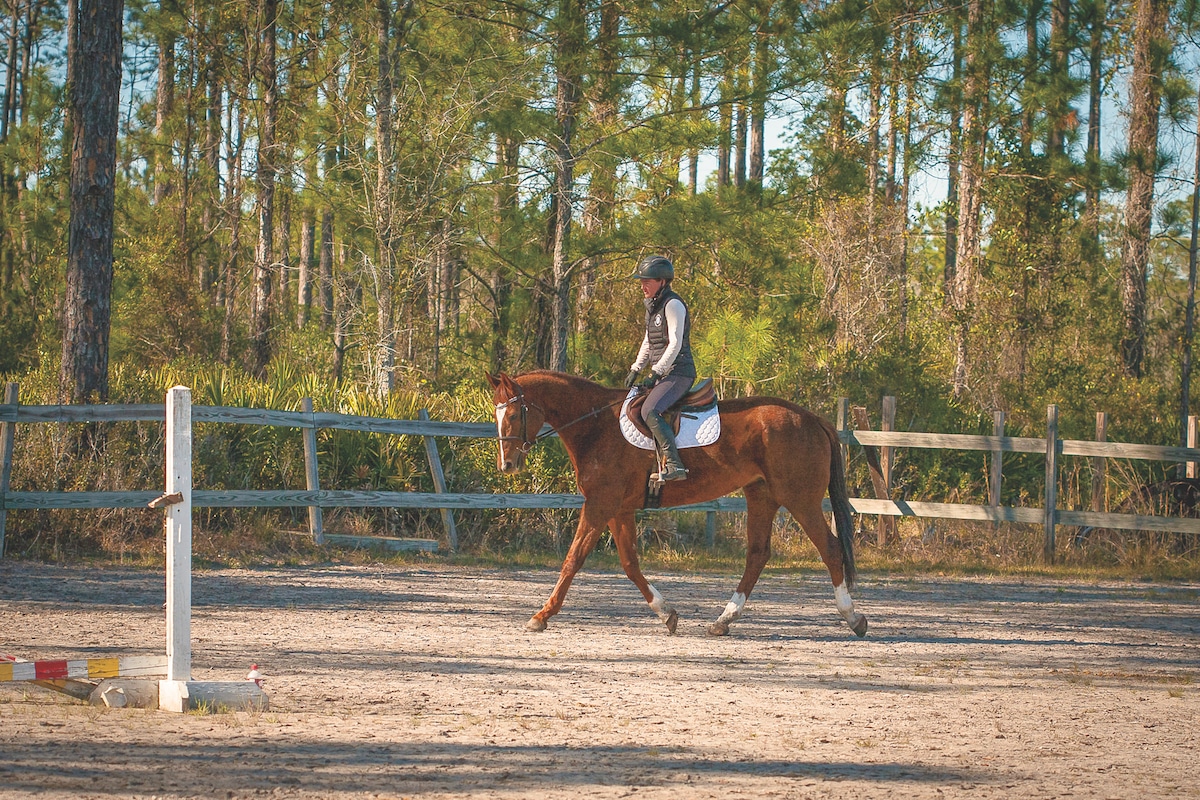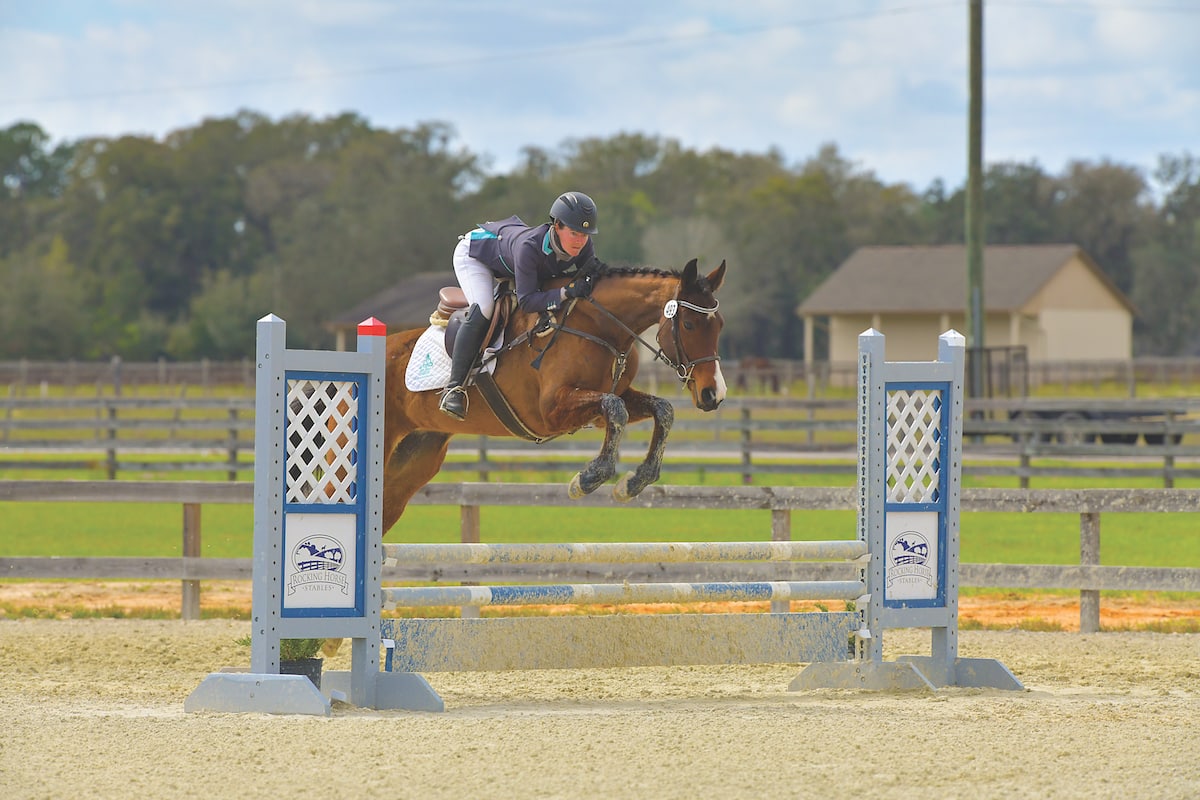Trainers explain why they don’t overlook a nice OTTB just because she’s a mare

Kaitlin Hartford is training two mares for the 2021 Makeover, including team horse Goodbitofbizness, who bucks the chestnut mare stereotype. Courtesy Jessie Hartford
Riders arguably fall into two camps: mare-lovers and mare-avoiders. Either you believe nothing beats a good mare, or you deem them difficult to work with and even more so to sell.
But how did these stereotypes develop? And are we doing ourselves (and some talented horses) a disservice by passing on a filly or mare after she’s retired from racing?
We talked to two trainers and one researcher to try to answer these questions and, perhaps, persuade a few more riders to fall in love with the fairer equine sex.
Debunking Preconceived Notions
Moody. Opinionated. Difficult. Overly sensitive. These are just a few of the negative qualifiers owners and trainers have used to describe mares. They might stem from estrous-cycle-related behavioral changes, or they might simply be products of anthropomorphism.
Mare stereotypes “might be coming from the human world,” says Kate Fenner, PhD, a lecturer in horse behavior and training at the University of Queensland, in Australia. “Traditionally there are stereotypes against women, that they’re moody or bossy or difficult, and it’s possible that this has just transferred onto horses as well.”
But the science says these stereotypes aren’t based on fact. Fenner recently conducted a study of more than 1,200 horse owners via the online tool E-BARQ (Equine Behavior Assessment and Research Questionnaire) to assess the behavioral differences and rideability of mares versus geldings. Her team’s perhaps surprising finding? They noted no differences between mares and geldings under saddle.
“We did find a few sex-related differences in behavior, but these were all related to nonridden situations,” says Fenner. “And contrary to popular ideas, it wasn’t the mares who were more complicated in these cases, except for getting caught in the paddock. It was the geldings who were showing these largely unwanted behaviors.”
Kaitlin Hartford, a young professional eventer and veteran Thoroughbred Makeover trainer based in Callahan, Florida, believes mare stereotypes are rooted in myth, as well. “My personal favorite is the chestnut mare stereotype,” she says, adding that she and a group of adult amateur riders are training one (Goodbitofbizness [Fed Biz — Spottswoode, Master Command]) as a team horse for the 2021 Makeover. “She is just the sweetest thing, which, of course, goes against the notion that chestnut mares are angry and evil and you shouldn’t touch one with a 39.5-inch pole. I think some people think mares are a little more opinionated, but my 2018 (Thoroughbred Makeover) graduate who is a gelding is the most opinionated horse on the farm.”
Gritty, Sensitive & Smart
Cast in a different light, the attributes some riders deem undesirable in mares are what make them so appealing to others. Take the demanding sport of polo, for example. In this discipline, riders seek out and covet mares for their grit, competitive spirit and stamina.
Charles Muldoon, executive director of the U.S. Polo Association’s Umpires LLC and owner of Summerhill Polo, in Poolesville, Maryland, says that 90% of the polo ponies he has trained or ridden have been mares, and 90% of those were Thoroughbreds.
“We find they mature (mentally) a little earlier and are a little more gritty (than geldings),” he explains. “They tend to learn quickly and are more apt to do all the things we want them to do at a faster pace. They retain stuff easier than geldings. Polo is a very physical, very competitive game, and mares seem to be more competitive when they go on the field. They just give you everything all the time.”
Hartford prefers mares — but finds them harder to acquire after they retire from racing because good ones go on to be broodmares — for similar reasons.
“Mares tend to try a little harder and are a little more aware of their surroundings,” she says. “Geldings are like, ‘Oh you want me to jump off a bridge? I can jump off a bridge!’ Mares are going to say, ‘I don’t think that’s our best plan, but we can at least try.’ I want to sit on a horse that’s a little more aware of what they’re doing and have their own cautious level of what’s going on, especially for what I do.”
Muldoon admits that a highly tuned mare isn’t always the best match for every rider and discipline. Weekend warriors and low-level amateurs in any sport might be happier with a quiet mare or a gelding.
“In polo, we’re fine-tuning them all the time, and mares really respond to that,” he says. “We want them ready, to have power at all times, like a Ferrari where you push on the gas and they just go. At the professional level, we want speed, power and handling all together like a race car. The average person playing polo can’t handle a race car, so we do need more of a streetcar for them, and we have mares that do that as well.”
Hartford has noticed that mares also tend to form strong connections with their people: “In the long run, they’re going to give you the shirt off their back a little quicker than a gelding would once you have that bond with them.”
An added bonus when you own a mare? She can transition to a breeding career at the end of her performance years.
Being Open-Minded

Kaitlin Hartford’s other Makeover mare, Gumdrop’s Chiclet (Uptowncharlybrown — Gumdrop, Lemon Drop Kid), has been quick to develop and exciting to bring along. Xpress Photo courtesy Kaitlin Hartford
To the rider who balks at buying a mare or the trainer who thinks she can’t sell one, Hartford offers this piece of advice: Open your eyes.
“You’re going to find a lot more if you open your mind up to looking at something else,” she says. “There are a lot of horses hiding behind a gender bias that are super-talented. And because some people aren’t willing to look at mares, you can find great ones that have been skipped over. You don’t want to miss a diamond in the rough because it’s a mare, not a gelding.”
Muldoon offers the Thoroughbred Touch of Class (Yankee Lad — Kluwall, Cornwall), who garnered fame and Olympic gold medals in show jumping in the 1980s, as a shining beacon for what mares can do. She was a feisty little horse that many people doubted for her size and sex, but rider Joe Fargis trusted her, and she took him to the pinnacle of the sport.
“If you’re a top trainer, you want a good horse,” Muldoon says. “If you’re a trainer of any discipline, you don’t turn down mares because of stigma. You look at the horse, not the sex. If you’re looking at the most beautiful thing, and it fits your criteria but it’s a mare, well, I think that’s a pretty special horse.”
Hartford points out that every horse, regardless of its sex, is going to have some degree of attitude and a learning curve. It’s the rider’s job to treat that horse as an individual and give her the time and attention she needs to reach her potential.
Says Muldoon, “Mares, when they hit the ground, God touches them and says, ‘You’re going to be incredible at this.’ It’s up to us as trainers to figure out what that is: Are they incredible jumpers, are they incredible racehorses, are they incredible polo ponies? The great ones, they’re naturals.”
Why Do We Care?
One of the reasons it’s important to avoid falling prey to common misconceptions about mares is animal-welfare-related. If riders and handlers have preconceived gender-based ideas about a horse’s behavior, temperament or rideability, those ideas can affect how they interact with and treat that horse, says Kate Fenner, PhD, from the University of Queensland, in Australia.
“If you go into a riding session with this type of bias, you’re not going to be a proactive rider but a reactive one, and that forces you down the punishment road, reacting to or correcting the horse,” she explains. “(Or you can) go into the ride assuming that if the mare doesn’t do what you wanted, it is because she didn’t understand. This way you can be proactive and prepared to teach the mare. And you can take responsibility for misunderstandings on yourself as a rider rather than blaming your horse for being a mare. You can tell yourself, ‘She didn’t do what I wanted her to do because I didn’t explain it well enough.’ Giving her the benefit of the doubt is ultimately much better for her welfare.”
Behavior and temperament often affect horses’ merit as riding partners and companions. By being open-minded and educated about mares, says Fenner, we can work toward developing better training methods and reducing horse wastage.

